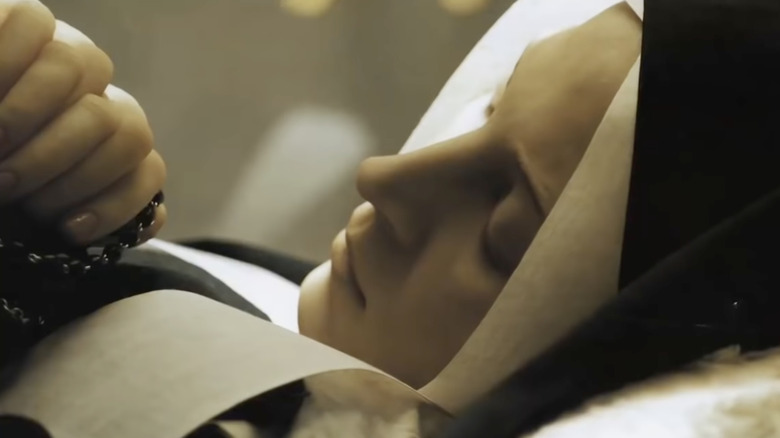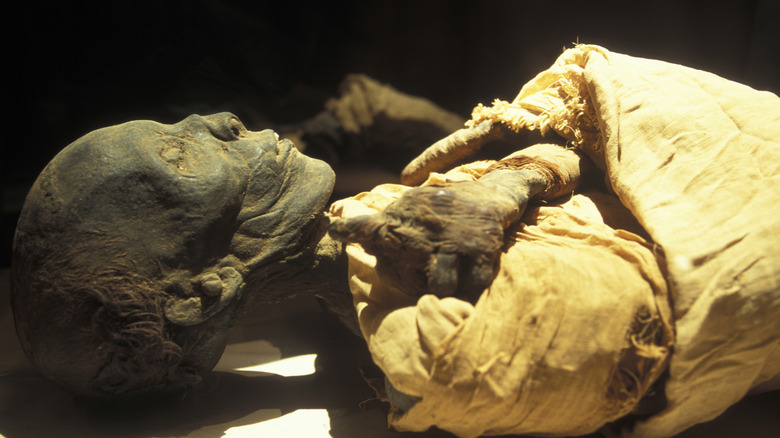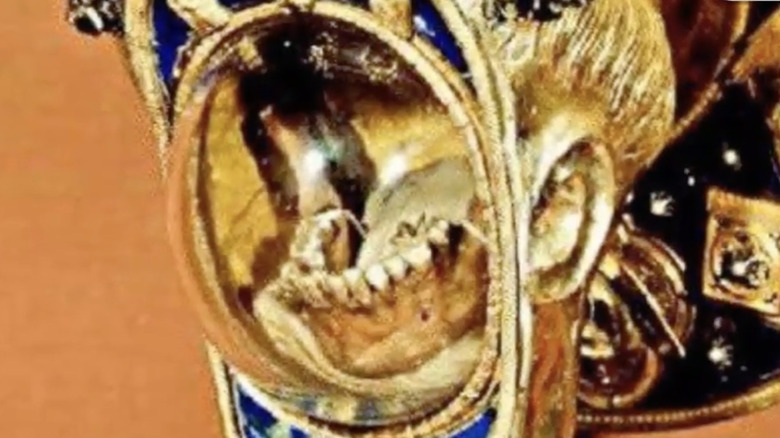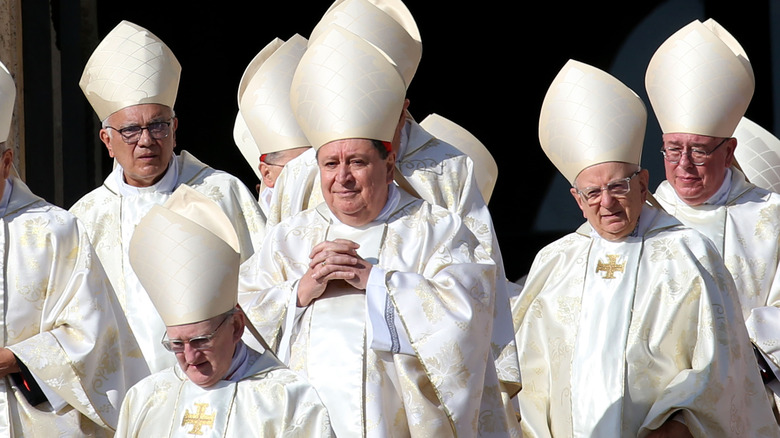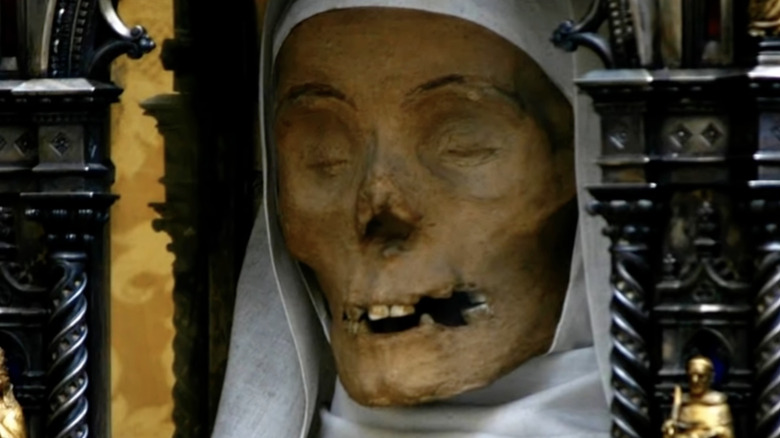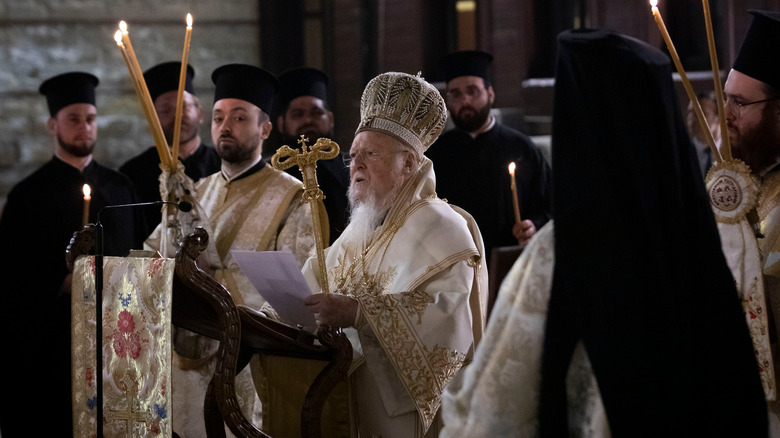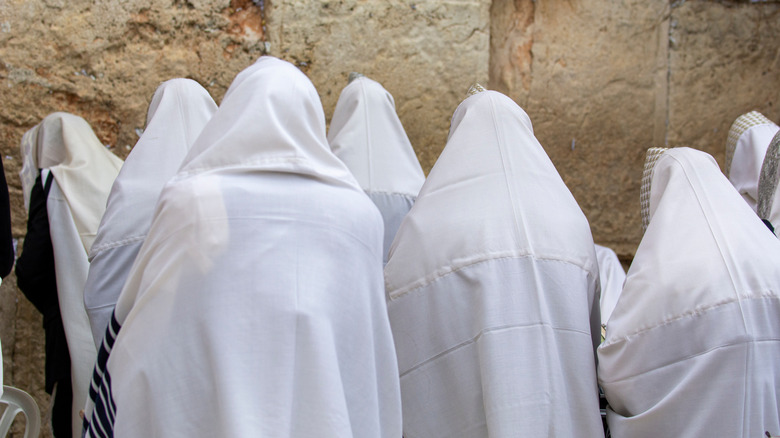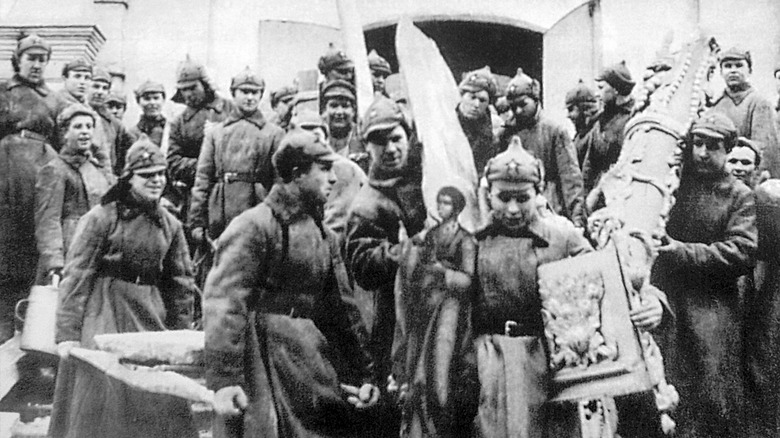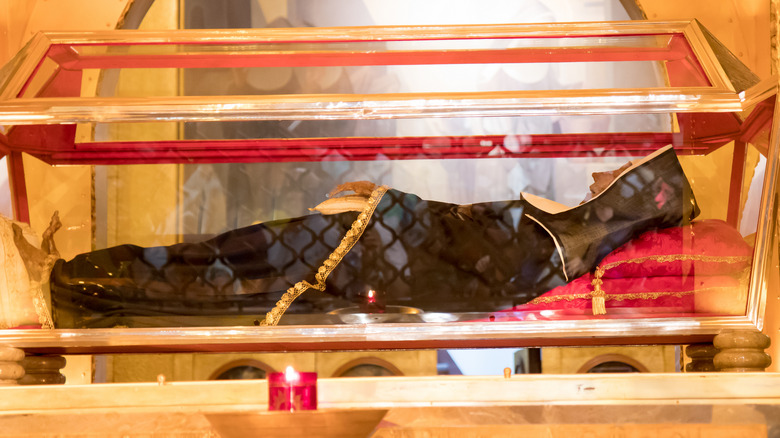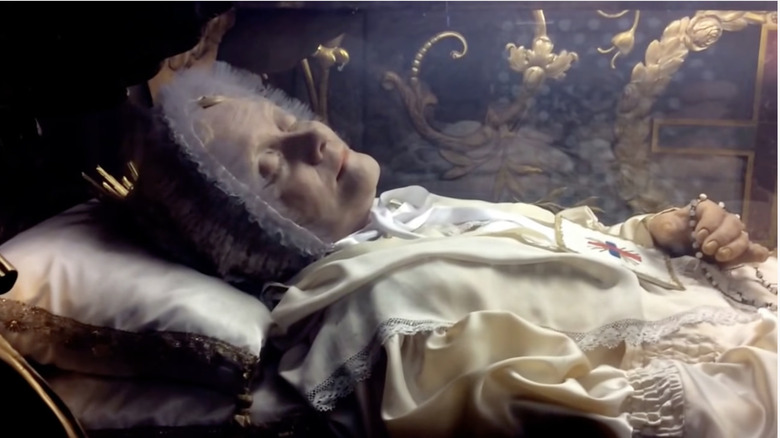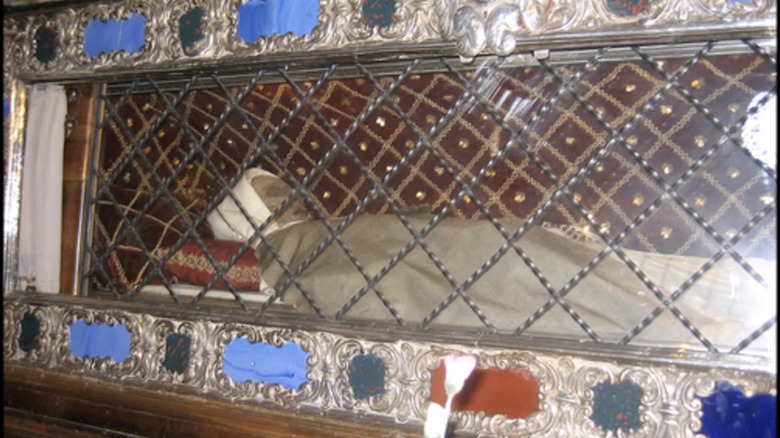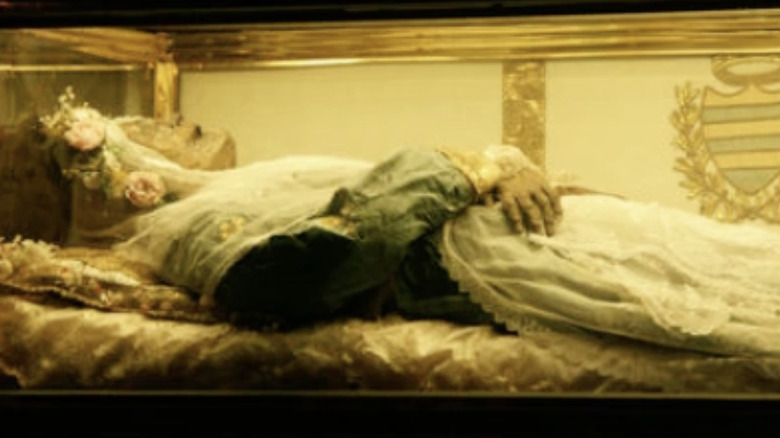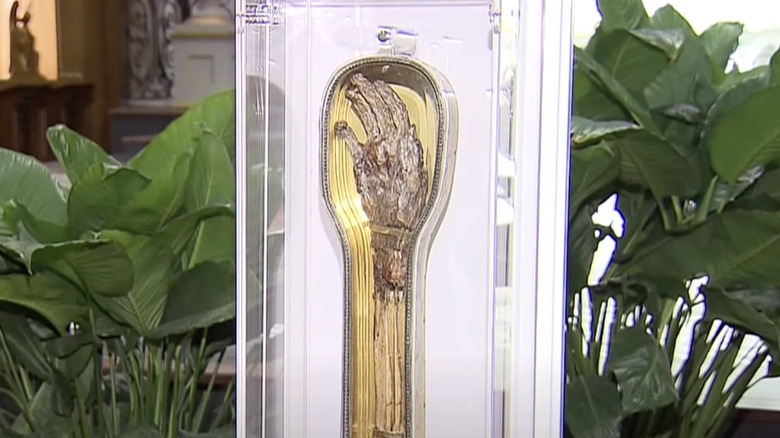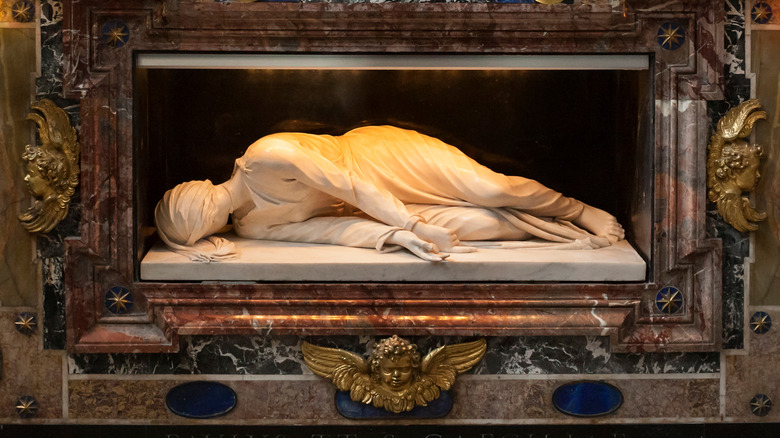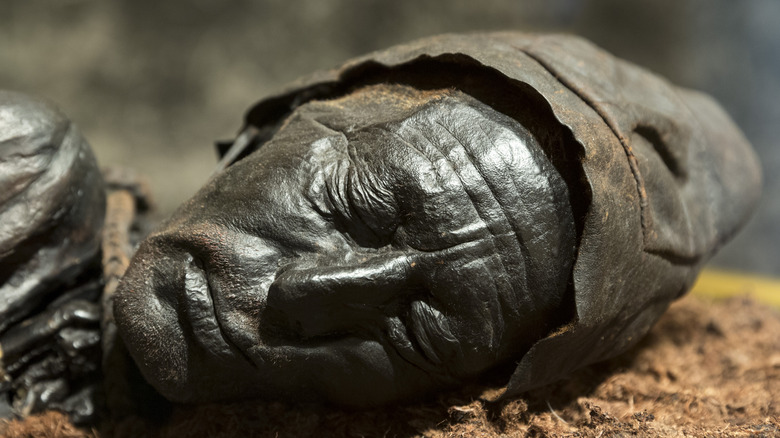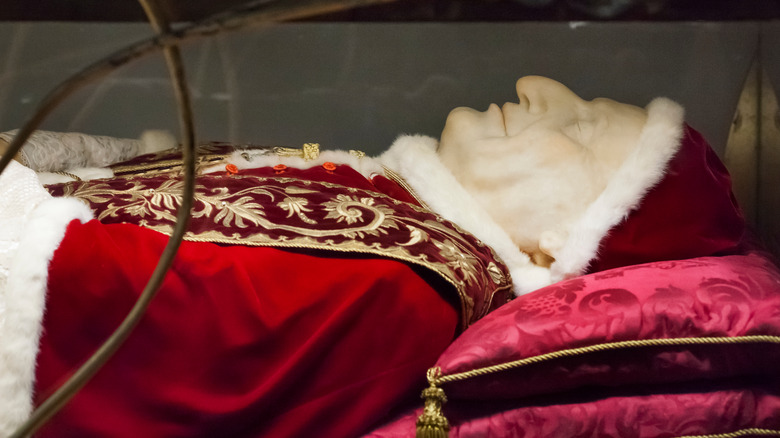What Are Incorruptible Saints And Why Don't Their Bodies Decay?
Way back in 1716, the English playwright Christopher Bullock declared, "'Tis impossible to be sure of anything but Death and Taxes." This fortuitous phrase from his play "The Cobbler of Preston" hit a chord and would take various forms over the centuries attributed to far-ranging thinkers from Benjamin Franklin to Mark Twain. But, of course, there's another inevitability we could add to this statement: bodily corruption.
An unpleasant yet necessary reality, the human body begins decomposing within moments of death (via the BBC). Scientists have studied the stages of corpse decay, from the first few moments after death to the final stages of becoming a de-fleshed skeleton, per Medical News Today. The processes in between — including livor mortis, rigor mortis, and algor mortis — have been thoroughly documented. So, it's strange, maybe even miraculous, when a human body bucks these trends and remains incorruptible.
Such is the state of affairs with so-called "incorruptible saints," as reported by Britannica. These purportedly supernatural attractions have long drawn the faithful to Catholic and Eastern Orthodox churches with claims of saintly bodies untouched by time and decomposition. But is there any truth to these claims? Here's the scoop on incorruptible saints and why some say their bodies have stood the test of time.
Christianity and miracles surrounding death and resurrection
Central to the Christian faith is the concept of mortality, the result of the "original sin" that transpired with Adam and Eve's fall in the Garden of Eden, per Britannica. To gain liberation from these "sins of the father" visited on all descendants of Adam and Eve, early Christians believed Jesus Christ died on the cross and was resurrected on the third day. He represented both the ultimate sacrifice and the overthrower of "original sin" and death.
Besides Jesus' miraculous resurrection, he also raised individuals from the dead during his lifetime, including Lazarus, who famously spent three days stinking up his tomb before Jesus transformed him into a living human being. For some early Christians, a natural extension of such miracles would be incorruptibility after death, a sign of holiness.
According to Britannica, a corpse must prove immune to "the usual forces of putrefaction" to meet the requirements of incorruptibility. This means the body must be in a natural state with no other explanation for the preservation, such as embalming or environmental conditions that arrest decay. In other words, bog bodies and naturally occurring mummies need not apply.
Incorruptibles versus bodies preserved by other means
According to Joan Carroll Cruz's "The Incorruptibles: A Study of the Incorruption of the Bodies of Various Catholic Saints and Beati," a distinction exists between miraculously preserved bodies and those that have accidentally or deliberately experienced arrested decay. For example, Smithsonian notes that the most famous artificially preserved bodies are ancient Egyptian pharaohs. Archaeologists believe the inspiration for Egyptian mummification came from finding bodies naturally preserved in Egypt's arid environment. But Egyptian mummies are a relatively late arrival on the scene.
The oldest mummies in the world come from South America and date to over 7,000 years ago, according to the BBC. Known as the mummies of Chinchorro, researchers believe they drew knowledge of cadaver preservation from naturally desiccated ancestral peoples in Chile's Atacama Desert. Similar conditions in northwestern China protected the 4,000-year-old Tarim mummies, as reported by Smithsonian. In each of these cases, the lack of bodily decay can be explained.
That's what sets incorruptibles apart from regular mummies — natural phenomena can't always explain away these well-preserved remains. What's more, they display bizarre characteristics not present with mummies and other preserved cadavers. In Cruz's book, she notes their alleged lifelike appearances, flexibility, and retention of "blood and clear oils." Many also reportedly contain a sweet scent, defying normal decomposition processes. Instead, incorruptibility appears to usurp science and reality, with corpses arrested beyond physical decay. Early Christian groups concluded they represented miracles from God.
Incorruptibility didn't have to be permanent
Incorruptibility didn't have to last forever to catch the attention of church leaders. As Britannica notes, "[it] does not imply that the body cannot subsequently rot" — purported supernatural preservation simply had to occur at some point in the corpse's history. This criterion worked for exceptionally preserved body parts, too.
Incorruptibles often underwent treatments thought to help preserve what God had already done. These might include acid baths and encasement in wax effigies. When it came to body parts, they were displayed separately (for example, St. Vincent de Paul's heart or St. Anthony of Padua's jaw and tongue). Whether incorruptibility marked a miracle or not, the bodies (and body parts) of saints received "great esteem" from Eastern Orthodox and Catholic faithful (via Britannica).
Even wear and tear didn't affect an incorruptible's status because miracles didn't have to continue indefinitely for the body to get categorized as supernatural. According to Joan Carroll Cruz's "The Incorruptibles," repairs took place as a matter of course. For example, Cruz notes work done on Saint Rita's body over the years, including using string and wax to improve her appearance. The repairs were noted in medical investigations from 1743 and 1892, and church authorities took these treatments in stride as necessary upkeep for maintaining the treasure of reliquaries in tiptop shape.
Relic-hunting led to these discoveries
You may wonder how the faithful stumbled across bodies in arrested decay. Simply Catholic says the discoveries stemmed from the process of canonizing saints, a lengthy procedure requiring exhumation of their bodies for several reasons.
First, locating a potential saint's corpse assured church officials that the individual in question had lived. Second, it permitted relics associated with the saint to be discovered and distributed to various churches around the globe. Remember that the official stance of both the Catholic and Eastern Orthodox churches was that even a saints' former belongings and remains could hold miraculous powers. But canonization for saints who had not faced martyrdom required clear evidence of post-mortem miracles, which meant having the saint's remains (whatever was left) on hand, per EWTN. Third, locating the potential saint's body permitted proper enshrining in a chapel or church. During exhumations, church fathers sometimes happened upon shocking discoveries, namely bodies or body parts extraordinarily well-preserved.
As an increasing number of so-called incorruptibles came to light, some faithful proved particularly swayed by this physical manifestation of the miraculous. Modern-day examples of this process at work include the candidacy for sainthood of Reverend Patrick Ryan by the Basilica of Saints Peter and Paul located in Chattanooga, Tennessee (via Courthouse News). The Catholic News Agency reports that Ryan's exhumation came with the discovery of relics, including vestments, a wooden crucifix, and a scapular that have been relocated along with his remains to the basilica, although no evidence of incorruptibility existed.
Roman Catholicism and Incorruptibles
The Catholic faith boasts dozens of so-called incorruptibles, according to Pacific Standard. Discover places the number around 100, noting more than half can be found in Italy. Other destinations for Incorruptible sightseeing include Poland, Spain, France, Belgium, Austria, India, Germany, Lebanon, and Peru. The disparity in numbers of incorruptibles isn't surprising when you consider the modern aversion many feel toward them. According to Heather Pringle's "The Mummy Congress: Science, Obsession, and the Everlasting Dead," many incorruptibles "have been sadly forsaken over the years, even by the faithful." So, establishing an official count is impossible.
To the most devout, however, incorruptibility represents a tangible display of divine intervention at work in the lives of God's faithful servants. Incorruptibles also are thought to perform miracles posthumously, especially healings. So, the bodies of the most famed incorruptibles remain on display in churches and chapels worldwide, even as visitor numbers have dwindled over the centuries.
Since the mid-20th century, the Catholic Church has called on science to better understand incorruptibles and aid in the preservation of contemporary figures' cadavers. In so doing, they've blurred the line between the supernatural and the scientific. Perhaps Ezio Fulcheri of the University of Genoa best articulates the Roman Catholic stance on incorruptibles today. In an interview with Discover, he argued, "What is a miracle? It's something unexplainable, a special event that may occur in different ways ... but don't exclude [rare] natural processes that are different from the normal course of things."
The role of Incorruptibles in the Eastern Orthodox faith
Like the Roman Catholic faith, the Eastern Orthodox church doesn't require incorruptibility as a prerequisite for canonization as a saint (via the Church of the Genuine Orthodox Christians of America). But it sure doesn't hurt, either. Also, like the Catholic faith, incorruptibility is highly esteemed and associated with other miracles, including healings.
The topic of incorruptibles is a somewhat sensitive one to the Eastern Orthodox Church, however. Although the church greatly esteems relics declared miraculous, fragrant, and incorrupt, it gets more complicated when it comes to human bodies. Although an unnaturally preserved cadaver may point to holiness, it can also happen for less-than-savory reasons.
The Third Synod of Moscow from 1666 declares (via the Church of the Genuine Orthodox Christians of America), "Let no one dare henceforth to honor and revere the bodies of the dead which even in these times are found whole and incorrupt as being holy without a credible witness and Synodical Approval." The statement goes on to argue that many undecayed bodies exist due to transgressions or loathing of church teachings. Other causes might include getting cursed by a priest or bishop or even ex-communication. Kind of like the scene in "Bram Stoker's Dracula" where Vlad renounces God and becomes a monstrously preserved immortal.
The legacy of Incorruptibles in Judaism
According to Britannica, Christianity sprung from the Jewish tradition. Not surprisingly, both faiths share many concepts in common, including monotheism, universal salvation, and the Hebrew Scriptures or Old Testament. So, it's little wonder that we find the concept of incorruptibility as a divine miracle in Judaism, too.
In the "Legends of the Jews" by Louis Ginzberg, there's a fascinating story about the prophet Baruch. As the text explains, "The piety of Baruch and the great favor he enjoyed with God were made known to later generations many years after his death." A Babylonian prince requested to see the gravesite of the prophet Ezekiel, the teacher of Baruch. Rabbi Solomon led him to the spot, but when the prince's attendants tried to open the tomb that Ezekiel shared with Baruch, they died on the spot.
So, the prince summoned Jews to do the job. After praying and fasting, the tomb opened without incident. Even more astonishing, Baruch lay on the marble bier where they'd placed him so long ago. Yet, his body appeared in the same condition as when they interred him. The event proved so shocking to the prince that legend says he converted from Islam to Judaism. The Jewish Encyclopedia notes that the Syriac Apocalypse of Baruch claims Baruch got translated directly into paradise in his mortal body.
Critics of Incorruptibles
During the Bolshevik Revolution in Russia, Communists stormed the ancient churches of the Eastern Orthodox faith, pulling incorruptibles and relics from display cases, according to Dr. Peter J. Popoff in Maclean's. According to Popoff, the Bolsheviks laid waste to long-held religious beliefs through rampant, indiscriminate desecration. Then, in language rife with propaganda, they claimed the so-called miraculously preserved bodies were all wax figures. Of course, this message suited their need to neutralize "the opium of the people," as Karl Marx called religion (via The Economist).
Bolsheviks weren't the only ones with a beef against incorruptibles. Writing for The Herald, Bill Bain refers to them as "hamburgers of religious delusion." The "hamburger" part references urban legends about McDonald's Happy Meals that go for years unrefrigerated without a spot of mold. He argues in his piece, "A recent U.S. scientific study into fast food's mysterious ambivalence to nature concluded that the key to durable physicality wasn't any Judeo-Christian sky spy, creepy chemical or powdered preservative — but simply a lack of moisture and specific atmospheric conditions."
Bain points to various explanations for incorruptibles such as airtight coffins built from lead and zinc, burial in above-ground crypts, and "undocumented" embalming. What's more, HowStuffWorks points out that some alleged incorruptibles have proven fraudulent. As with the Eastern Orthodox church's stance on bodies that don't rot, the website also points out that some people whose corpses remain surprisingly lifelike led rather un-saintly existences (more on this later).
Scientists put incorruptibles under the microscope
A shift in the Catholic Church over the past few decades moved to examine incorruptibles more scientifically. This move hopes to bring about a better understanding of the phenomenon, per Heather Pringle's "The Mummy Congress." One scientist at the spearpoint of this research is Ezio Fulcheri at the University of Genoa. Instead of Incorruptibles, he prefers to refer to them as the "mummies of saints." A devout Catholic, Fulcheri has even been called in by the Vatican to preserve the corpses of modern-day individuals awaiting canonization.
The Vatican no longer lists incorruptibility among its official miracles, per Atlas Obscura. What's more, the Roman Catholic church has admitted that in some cases, bodies received help from the environment (although there's still the claim that God engineered that perfect environment), per Cabinet. Most famously, Cardinal Prospero Lorenzo Lambertini, the guy who snagged the title Pope Benedict XIV, was a proponent of using medical science to analyze supposed cases of incorruptibility objectively. Known as "the Enlightenment Pope," he concluded in his text "On the Beatification and Canonization of Saints" that most mummies of saints had natural rather than supernatural explanations.
The wonders of wax for incorruptibility
Among the media most effectively used to preserve incorruptibles is wax, per Atlas Obscura. Artists have used it to great success in maintaining reliquaries. Consider the case of Saint Bernadette: After dying on April 16, 1879, her canonization process involved three medical examinations in 1909, 1919, and 1925 (via Atlas Obscura). After her final exhumation, officials placed a thin layer of wax over her face and hands, and a famed fashion mannequin maker in Paris named Pierre Imans designed the wax prosthetics.
EWTN explains the wax "fixed" a few unsightly details noted in her third exhumation, including a blackish skin tinge. It also improved her nose, described as "dilated and shrunken," as early as her first examination. Church records show that Bernadette's body remained mostly incorrupt at its first exhumation. But afterward, nuns washed her body, likely contributing to the noticeable decay and mold noted at the second and third check-ins.
Atlas Obscura reports the Blessed Anna Maria Taigi (above) can still be seen in San Crisogono, Rome, today. You can attribute her lifelike appearance to wax portraiture over bone. And no one can deny the doll-like appeal of Saint Victoria, constructed around a skeleton of a catacomb martyr with cutaways revealing her relics (aka bones). Separating the wax from reality proves difficult with Saint Silvan — Martyred in the fifth century, he lies in a state of peaceful repose in Dubrovnik, Croatia (via Atlas Obscura). (Considering his great age, we're guessing he's more wax than not.)
Some Incorruptibles show obvious signs of embalming
Although saints like Bernadette and Anna Maria Taigi have gotten a little help from wax over the years, it's generally accepted their bodies were once incorrupt without any explanation. That means they didn't have the benefit of embalming or conditions specifically favorable to fleshly preservation. But not all mummies of saints fit this bill. As the Roman Catholic Church actively encouraged the scientific examination of its many reliquaries, some researchers found this out firsthand, per Heather Pringle's "The Mummy Congress."
As scientists opened glass coffins and peeled back layers of clothing with care, it quickly became evident the followers of these saints had embalmed them to make a better case for canonization. For example, when University of Genoa researcher Ezio Fulcheri examined the body of Margaret of Cortona, he found several long incisions streaking her thighs. He also noted deeper cuts in her chest and abdomen that had been stitched together post-mortem. Pringle writes in her book, "Those who preserved St. Margaret had done so remarkably thoroughly, excising her internal organs and drenching her skin in fragrant lotions."
Besides Margaret of Cortona, saints embalmed by their followers include Clare of Montefalco, Blessed Margaret of Metola, Catherine of Siena, Rita of Cascia, and Bernardine of Siena. Like Margaret, they bear obvious signs of embalming: organ removal, post-mortem incisions, and stitching. All of these so-called incorruptibles date to the period between 1297 and 1447, and all were mystics with devoted followings.
Other cases of incorruptibility remain a mystery
Unlike most of the incorruptibles who at one point or another had a little cosmetic work done, if not full embalming, Saint Zita remains a fascinating mystery, according to Heather Pringle's "The Mummy Congress." Located in a side chapel in the San Frediano Basilica, her body lays on a brocade bed, and she's viewable through a glass shrine.
Pringle describes seeing her more than 700-year-old cadaver this way: "Her gaunt face was smooth and her hands soft and supple-looking. Her lustrous nails gleamed." When examined by researchers, they found no signs of human tampering to preserve the saint's body. Scans confirmed the presence of all of her organs, and researchers found no signs of incisions. No resins or unguents were detected on her skin, making her incredible preservation inexplicable.
Other saints that fall into this category include Ubald of Gubbio, Blessed Margaret of Savoy, and Saint Savina Petrilli. After examining Zita, Ezio Fulcheri had no explanation other than environmental factors. He hypothesizes that Zita's entombing in burial vaults beneath church floors may have something to do with their frozen-in-time features today.
Incorrupt body parts count, too
Making a pilgrimage to see a saint's body isn't always possible. For example, visiting Saint Francis Xavier's mummy requires a trip to Goa, India (per Atlas Obscura), so sacred body parts represent the next best thing. Notably, Francis Xavier's 465-year-old preserved arm sometimes travels — in 2018, it made a whirlwind tour of Canada (via America Magazine). On a practical note, toting a withered arm in a case is much easier than dragging along an entire body, especially when it comes to Customs!
Another body-part honorable mention is Saint Anthony's tongue (via Atlas Obscura). After the popular saint died in 1231 of edema, his body decayed, which church officials realized during his first exhumation in 1263. Oddly enough, though, his tongue looked totally fine and proved flexible and wet, as if the famed church orator were about to take another stab at it. Church leaders soon declared the tongue preserved because of his perfect teachings, and today, the saint's tongue and lower jawbone rest in elaborate gold reliquaries at the Basilica of Saint Anthony in Padua, Italy.
Another saint whose corporeal preservation proved hit or miss, Vincent de Paul's heart is about all we have left from the man except for a pile of bones (via Atlas Obscura). The skeleton now sits beneath exquisitely sculpted layers of wax, giving him a lifelike appearance, and a golden reliquary at the Sisters of Charity in Paris houses his heart, per "The Incorruptibles."
The incorruptible preserved in marble
Up to this point, we've taken a look at incorruptibles who've left behind some type of physical presence, whether it's a flesh-covered body, a pile of bones, or an extra well-preserved heart or tongue. This reflects the belief that incorruptibility doesn't have to last forever (or apply to an entire corpse) for the acknowledgment of a miracle, per Britannica. Generally, these sacred artifacts, no matter their state, get housed in specially designed reliquaries showcasing them for pilgrims.
But not all saints stay on display forever. Their earthly remains don't always sit behind the protection of a glass coffin or beneath a thin wax veneer. Instead, art has stepped in to provide a suitable physical manifestation. The incomparable marble statue of Saint Cecilia by Stefano Maderno marks a perfect example of this. According to Joan Cruz's "The Incorruptibles," Maderno relied on an eyewitness account by Antonio Bosio, who, along with Cardinal Baronius, found Cecilia in the catacombs.
Nearly 1,500 years after her death, Bosio claims she lay in the exact same position in which she died — a veil draped over her incorrupt body. After placing Cecilia on display for a month, the relic went into a silver coffin that church officials interred beneath the main altar of the Santa Cecilia Church in Trastevere, Rome, per Atlas Obscura. The saint's body rests in peace while Maderno's incredible marble rendition inspires the faithful.
Incorruptibles who don't fit the mold
Incorruptible naysayers have plenty of criticism for macabre relics, per The Herald. One of their most compelling stances deals with individuals who are well-preserved but were less-than-saintly. These include the Italian Archbishop Cardinal Shuster, whose corpse proved incorrupt 31 years after death (via HowStuffWorks). Yet, he had a reputation as a fascist and bosom buddy of Benito Mussolini. Some people think that's more than enough reason for his corpse to decay.
There's also Rosalia Lombardo of Sicily, who perished as a toddler, according to The Misery Machine. Her heartbroken father hired the best embalmer money could buy, proving worth every penny. The embalming process left her astonishingly lifelike. Housed in the Capuchin Catacombs of Palermo, Sicily, the haunting appearance of the little "sleeping beauty" draws visitors from all over the world.
And we can't forget about individuals like the Iron Age Tollund Man, found in Denmark's Silkeborg bog in 1950, per TIME. His body looks so fresh that his discoverers thought they'd stumbled across a contemporary murder scene. But as they examined the corpse, they realized that from his head to his toes, the man embodied a time capsule — one that dated to between 375 and 210 B.C. His perfect preservation, which includes bodily organs, resulted from the unique environmental factors of the bog, including a lack of oxygen, a dearth of bacteria, and cool temperatures year-round. While his remains would be the envy of any wannabe saint, his pagan lifestyle breaks the canonization mold.
Contemporary attempts to create Incorruptibles have proven fatal
Modern-day attempts to preserve the bodies of saints, both past and present, have come at the ultimate cost, as reported by The New York Post. A team of researchers assembled by the Vatican in the 1970s to improve upon the mummification process worked with such dangerous chemicals that all but one member died from cancer, and, understandably, no one has the nerve to continue the work they began.
Per The New York Post, from 1975 to 2008, the team preserved 31 bodies of "saints, beatified, and servants of God." They worked on everything from centuries-old mummies of saints to specific body parts in a battle to beat decomposition. But their struggle against the forces of nature backfired as team members soon started dropping like flies. The team included anthropologists, radiologists, medical surgeons, pathologists, and microbiologists. Yet, stunningly, they failed to recognize the inherent danger they faced.
The preservation of Pope John XXIII's corpse attests to their meticulous skill. To retain his incorruptibility, the team suspended his body for "months at a time" (per The New York Post) in baths of various chemicals, including methanol, ethanol, camphor, phenol, nitrobenzene, benzoic acid, and even turpentine. They bandaged him in linen soaked in ethanol and mercury bichloride and finished with a thin wax mask for good measure. But working with such dangerous chemicals proved fatal, a shocking price to pay for corporeal immortality.
